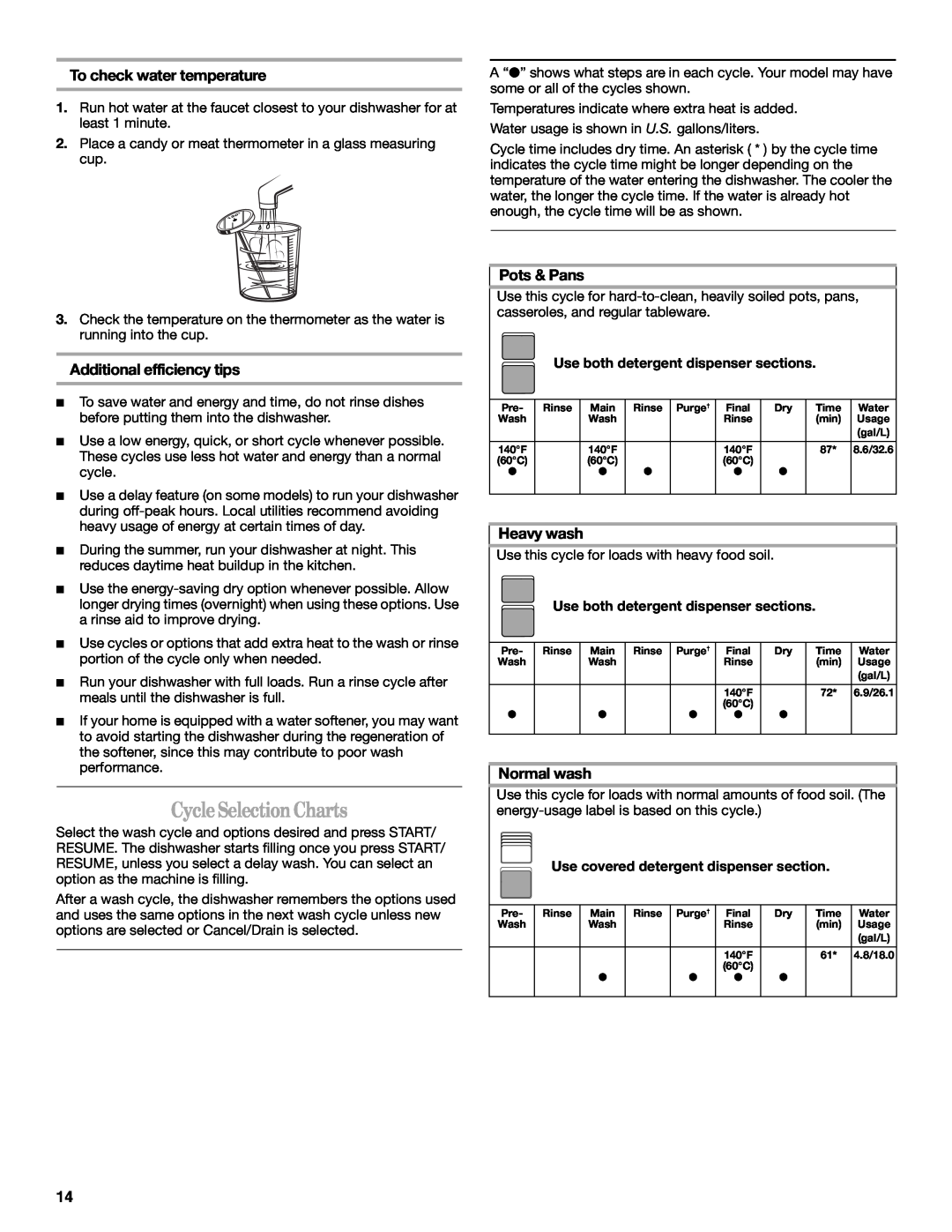In Canada, for assistance, installation or service
Models/Modèles DU915, DU930 DP940, DU945, DU948
W10073400B
Au Canada, pour assistance, installation ou service
CONNECTING THE DISHWASHER
DISHWASHER SAFETY
PARTS AND FEATURES
TROUBLESHOOTING
IMPORTANT SAFETY INSTRUCTIONS
DISHWASHER SAFETY
Your safety and the safety of others are very important
DANGER
For a grounded, cord-connected dishwasher
GROUNDING INSTRUCTIONS
SAVE THESE INSTRUCTIONS
For a permanently connected dishwasher
A B C D E F
PARTS AND FEATURES
Other features your dishwasher may have
I J K L M N O P
ControlPanels
UsingYourNew Dishwasher
UNDERCOUNTER START-UP GUIDE
Series DU915, DU945 Series DU930, DP940, DU948
PORTABLE START-UP GUIDE
Stopping YourDishwasher
Connecting the faucet adapter to faucets with external threads
CONNECTING THE DISHWASHER
ConnectingtheFaucetAdapter
Connecting the faucet adapter to faucets with internal threads
DisconnectingtheDishwasher
ConnectingtoWaterandElectrical Supply
UsingtheFaucet
DISHWASHER LOADING
LoadingTopRack
Adjustable 3-position top rack on some models
To adjust the top rack
LoadingBottomRack
Style 2 on some models Models with ANYWARE silverware basket
LoadingSilverwareBasket
Style 1 on some models
To open the silverware basket
To remove the basket from the door
DISHWASHER USE
DetergentDispenser
To replace the basket in the door
DishwasherEfficiencyTips
Where to fill
RinseAidDispenser
Checking the dispenser
Additional efficiency tips
CycleSelection Charts
To check water temperature
Pots & Pans
To clear the indicators
CancelingaCycle
ChangingaCycleorSetting
AddingItemsDuringaCycle
DryingSystem
CycleStatus Indicators
Clean
Overfill Protection Float
Dishwasher Safe?/Comments
WASHING SPECIAL ITEMS
Material
Cleaning the interior
Cleaning
Cleaning the exterior
To clean interior
White residue on the front of the access panel
TROUBLESHOOTING
Dishes are not completely clean
Dishwasher is not operating properly
Dishes are damaged during a cycle
Spots and stains on dishes
Dishes do not dry completely
Noises
In theU.S.A
ASSISTANCE OR SERVICE
If you need replacement parts
InCanada
DISCLAIMER OF IMPLIED WARRANTIES LIMITATION OF REMEDIES
ONE YEAR LIMITED WARRANTY
ITEMS WHIRLPOOL WILL NOT PAY FOR
call
Votre sécurité et celle des autres est très importante
SÉCURITÉ DU LAVE-VAISSELLE
DANGER AVERTISSEMENT
IMPORTANTES INSTRUCTIONS DE SÉCURITÉ
Pour un lave-vaisselle relié à la terre, branché avec un cordon
INSTRUCTIONS DE MISE À LA TERRE
CONSERVEZ CES INSTRUCTIONS
Pour un lave-vaisselle branché en permanence
K. Plaque signalétique des numéros de modèle et de série
PIÈCES ET CARACTÉRISTIQUES
Autres caractéristiques possibles de votre lave-vaisselle
L. Module du filtre POWER CLEAN M. Bras d’aspersion inférieur
AVERTISSEMENT
Tableauxdecommande
GUIDE DE MISE EN MARCHE - SOUS COMPTOIR
Utilisation devotrenouveau lave-vaisselle
Utilisationdevotrenouveau lave-vaisselle
GUIDE DE MISE EN MARCHE APPAREIL MOBILE
Arrêtdu lave-vaisselle
Connexiondel’adaptateur pourrobinet
CONNEXION DU LAVE-VAISSELLE
Préparation du robinet
Utilisationdurobinet
CHARGEMENT DU LAVE-VAISSELLE
Connexionà lasourced’eau et d’alimentation électrique
Déconnexiondu lave-vaisselle
Panier supérieur réglable à 3 positions sur certains modèles
Chargementdupaniersupérieur
Conseils de fonctionnement silencieux
Pour ajuster le panier supérieur
Style 1 sur certains modèles
Chargementdu panierinférieur
Chargementdupanieràcouverts
Style 2 sur certains modèles Modèles avec panier à couverts ANYWARE
Pour retirer le panier de la porte
Pour réinstaller le panier dans la porte
Porte-ustensiles sur certains modèles
Quantité de détergent à utiliser
UTILISATION DU LAVE-VAISSELLE
Distributeurdedétergent
Où remplir
Vérification du distributeur
Distributeurd’agentderinçage
Conseils d’efficacitépourle lave-vaisselle
Contrôle de la température de l’eau
Heavy wash/lavage intense
Tableauxdesélectiondeprogrammes
Pots & Pans/casseroles
Normal wash/lavage normal
Additiondevaisselledurantun programme
Annulation d’un programme
Changementd’unprogrammeou réglage
Sélection d’options
Indicateursd’étatd’avancementdu programme
Pour déverrouiller les commandes du lave-vaisselle
Clean/propre
Systèmedeséchage
Lavable au lave-vaisselle?
LAVAGE D’ARTICLES SPÉCIAUX
Matériau
Commentaires
Dispositif anti-refoulement
ENTRETIEN DU LAVE-VAISSELLE
Nettoyage
Remisage
Vaisselle pas complètement nettoyée
DÉPANNAGE
Le lave-vaisselle ne fonctionne pas correctement
Présence de taches sur la vaisselle
Bruits
Vaisselle pas complètement sèche
Vaisselle endommagée au cours d’un programme
Marques noires ou grises sur la vaisselle
Au Canada
ASSISTANCE OU SERVICE
AuxÉtats-Unis
Si vous avez besoin de pièces de rechange
WHIRLPOOL NE PRENDRA PAS EN CHARGE
GARANTIE DES GROS APPAREILS MÉNAGERS WHIRLPOOL CORPORATION
GARANTIE LIMITÉE DE UN AN
6/07
W10073400B
2007 Whirlpool Corporation
All rights reserved
